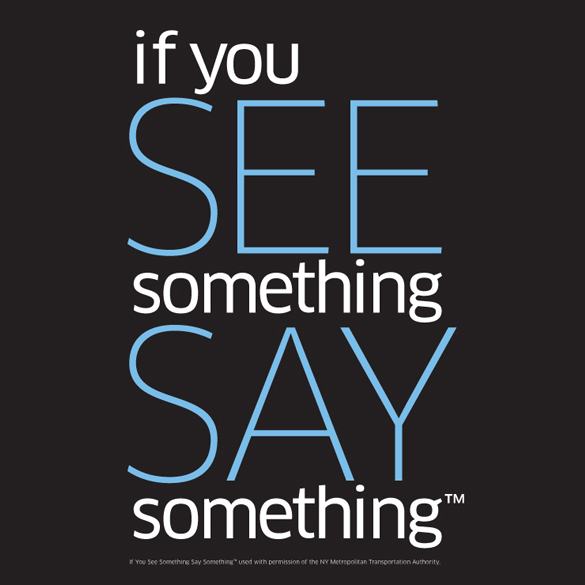“There were relatively few secret police, and most were just processing the information coming in. I had found a shocking fact. It wasn’t the secret police who were doing this wide-scale surveillance and hiding on every street corner. It was the ordinary German people who were informing on their neighbors.”—Professor Robert Gellately
If you see something suspicious, says the Department of Homeland Security, say something about it to the police, call it in to a government hotline, or report it using a convenient app on your smart phone.
(If you’re a whistleblower wanting to snitch on government wrongdoing, however, forget about it—the government doesn’t take kindly to having its dirty deeds publicized and, God forbid, being made to account for them.)
For more than a decade now, the DHS has plastered its “See Something, Say Something” campaign on the walls of metro stations, on billboards, on coffee cup sleeves, at the Super Bowl, even on television monitors in the Statue of Liberty. Now colleges, universities and even football teams and sporting arenas are lining up for grants to participate in the program.
This DHS slogan is nothing more than the government’s way of indoctrinating “we the people” into the mindset that we’re an extension of the government and, as such, have a patriotic duty to be suspicious of, spy on, and turn in our fellow citizens.
This is what is commonly referred to as community policing. Yet while community policing and federal programs such as “See Something, Say Something” are sold to the public as patriotic attempts to be on guard against those who would harm us, they are little more than totalitarian tactics dressed up and repackaged for a more modern audience as well-intentioned appeals to law and order and security.
The police state could not ask for a better citizenry than one that carries out its own policing.
After all, the police can’t be everywhere. So how do you police a nation when your population outnumbers your army of soldiers? How do you carry out surveillance on a nation when there aren’t enough cameras, let alone viewers, to monitor every square inch of the country 24/7? How do you not only track but analyze the transactions, interactions and movements of every person within the United States?
The answer is simpler than it seems: You persuade the citizenry to be your eyes and ears. You hype them up on color-coded “Terror alerts,” keep them in the dark about the distinctions between actual threats and staged “training” drills so that all crises seem real, desensitize them to the sight of militarized police walking their streets, acclimatize them to being surveilled “for their own good,” and then indoctrinate them into thinking that they are the only ones who can save the nation from another 9/11.
As historian Robert Gellately points out, a Nazi order requires at least some willing collaborators to succeed. In other words, this is how you turn a people into extensions of the omniscient, omnipotent, omnipresent police state, and in the process turn a citizenry against each other.
It’s a brilliant ploy, with the added bonus that while the citizenry remains focused on and distrustful of each other and shadowy forces from outside the country, they’re incapable of focusing on more definable threats that fall closer to home—namely, the government and its cabal of Constitution-destroying agencies and corporate partners.
Community policing did not come about as a feel-good, empowering response to individuals trying to “take back” their communities from crime syndicates and drug lords. Rather, “Community-Oriented Policing” or COPs (short for Community Partnerships, Organizational Transformation, and Problem Solving) is a Department of Justice program designed to foster partnerships between police agencies and members of the community. (Remember, this is the same Justice Department which, in conjunction with the DHS, has been providing funding and equipping local police agencies across the country with surveillance devices and military gear. These same local police have been carrying out upwards of 80,000 SWAT team raids a year on individuals, some of whom are guilty of nothing more than growing tomatoes, and breeding orchids without the proper paperwork.)
Mind you, this is a far cry from community engagement, which is what I grew up with as a kid. Then as now, there were always neighbors watching what you bought, what you said, what you did, who you did it with, etc. My own mother proudly peered out our living room window with a pair of military-issue binoculars to keep an eye on the goings on in the neighborhood. The difference was that if there was a problem, it was dealt with as a community. When my neighbor spied me running through his flower garden, he didn’t call the cops—he called my mother. When I sassed the manager of the general store, he didn’t turn me in to the cops—he reported it to my mother. Likewise, when my next-door neighbor (who happened to be the police chief) caught me in the act of egging cars one Halloween, he didn’t haul me down to the precinct—“I’m taking you to a far worse place,” he said, “your Dad.”
So, if there’s nothing wrong with community engagement, if the police can’t be everywhere at once, if surveillance cameras do little to actually prevent crime, and if we need to “take back our communities” from the crime syndicates and drug lords, then what’s wrong with community policing and “See Something, Say Something”?
What’s wrong is that these programs are not, in fact, making America any safer. Instead, they’re turning us into a legalistic, intolerant, squealing, bystander nation content to report a so-called violation to the cops and then turn a blind eye to the ensuing tragedies.
Apart from the sheer idiocy of arresting people for such harmless “crimes” as raising pet chickens, letting their kids walk to the park alone, peeling the bark off a tree, holding prayer meetings in their backyard and living off the grid, there’s also the unfortunate fact that once the police are called in, with their ramped up protocols, battlefield mindset, militarized weapons, uniforms and equipment, and war zone tactics, it’s a process that is near impossible to turn back and one that too often ends in tragedy for all those involved.
For instance, when a neighbor repeatedly called the police to report that 5-year-old Phoenix Turnbull was keeping a pet red hen (nickname: Carson Petey) in violation of an Atwater, Minnesota, city ordinance against backyard chickens, the police chief got involved. In an effort to appease the complaining neighbor and “protect a nearby elementary school from a chicken on the loose,” the police chief walked onto the Turnbull’s property, decapitated the hen with a shovel, deposited the severed head on the family’s front stoop, and left a neighborhood child to report the news that “the cops killed your chicken!”
Now things could have been worse. The police chief could have opted to do a SWAT-team style raid on the Turnbulls’ chicken coop, as other police departments have taken to raiding goat cheese farmers, etc. The Turnbulls could also have been made to serve jail time or pay a hefty fine for violating an established ordinance. In fact, this happens routinely to individuals who grow vegetable gardens and install solar panels in violation of city ordinances.
At a minimum, the Atwater city council needs to revisit its ban on backyard chickens, especially at a time when increasing numbers of Americans are attempting, for economic or health reasons, to grow or raise their own organic food, and the police chief needs to scale back on his aggression towards our feathered friends. But what about the complaining neighbor?
It’s fine to be shocked by the convergence of militarized police in Ferguson, Mo., it’s appropriate to be outraged by the SWAT team raid that left a Georgia toddler in the ICU, and it’s fitting to take umbrage with the inane laws that result in parents being arrested for leaving their 10-year-old kids in air conditioned cars while they run into a store, but where’s the indignation over the police state’s partners-in crime—the neighbors, the clerks, the utility workers—who turn in their fellow citizens for little more than having unsightly lawns and voicing controversial ideas?
In much the same way the old African proverb “it takes a village to raise a child” was used to make the case for an all-encompassing government program of social welfare, the DHS and the DOJ are attempting to make the case that it takes a nation to catch a terrorist.
To this end, the Justice Department identifies five distinct “partners” in the community policing scheme: law enforcement and other government agencies, community members and groups, nonprofits, churches and service providers, private businesses and the media.
Together, these groups are supposed to “identify” community concerns, “engage” the community in achieving specific goals, serve as “powerful” partners with the government, and add their “considerable resources” to the government’s already massive arsenal of technology and intelligence. The mainstream media’s role, long recognized as being a mouthpiece for the government, is formally recognized as “publicizing” services from government or community agencies or new laws or codes that will be enforced, as well as shaping public perceptions of the police, crime problems, and fear of crime.
Amazingly, the Justice Department guidelines sound as if they were taken from a Nazi guide on how to rule a nation. “Germans not only watched out for ‘crimes’ and other deviations” of fellow German citizens, Gellately writes, “but they watched each other.”
Should you find yourself suddenly unnerved at the prospect of being spied on by your neighbors, your actions scrutinized, your statements dissected, and your motives second-guessed, not to worry: as I point out in my book A Government of Wolves, this is par for the course in the American police state.
WC: 1640


